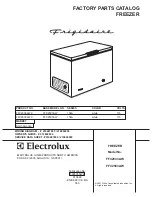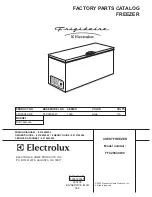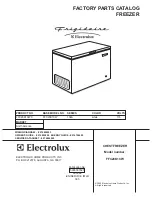
freezer improperly may jeopardize safety or cause undue
stress or damage to the refrigeration compressors.
Avoid opening the door for extended periods of time since
chamber air will escape rapidly. Room air, which is higher
in humidity, will replace chamber air and may cause frost to
develop in the chamber more rapidly.
4. CHECK OUT YOUR NEW FREEZER
4.1 Lid Seal
If the lid gasket does not seal along the front edge, relieve
the compression of the gasket along the back edge by
loosening the hinge screws where they attach to the cabinet.
Raise the lid slightly and then retighten the screws.
4.2 Interior Compartment Temperature
The temperature is controlled by a CAL 9500 digital
temperature controller. When you first power up the freezer,
the high stage compressor and fan will start and operate for 3
to 6 minutes before the low stage compressor starts. Pull
down to minimum temperature will take from 3 to 6 hours,
depending on ambient temperature and size of cabinet. The
high stage compressor runs 100% of the time. The low stage
compressor will cycle on and off to maintain the temperature
of the controller setting. Set the control to the desired set
point. To view the set point temperature, press the * and the
UP arrow keys together. To decrease the set point
temperature, press the * and the DOWN arrows keys
together.
Freezers are shipped from the factory with the indicating
digital control programmed for proper operation. All but the
temperature settings may be adjusted. The temperature
sensor is a type
“T”
thermocouple located on the front wall
of the inner-liner.
4.3
Alarm Signal System
The Alarm should be kept in the “OFF” position until the
cabinet temperature has reached the appropriate setting.
When the temperature has been reached, the temperature
alarm should be switched to the “ON” position and is now
ready to operate. It will monitor “temperature rise” and
“power-failure”. The control is factory set to operate the
alarm at approximately 10
F (6
C) above the set
temperature. No further adjustment is necessary unless a
spread other than this is desired. In the event a temperature
spread of more or less than factory set is desired, refer to
your digital temperature control manual.
NOTE: It is recommended to keep the freezer operating
continually rather than turning the freezer off and on.
5 ELECTRICAL CONNECTIONS
5.1 Wiring
This cabinet is equipped with a three-prong (grounding) plug
for your protection against shock hazards. The cabinet
should be plugged directly into a properly grounded three-
prong receptacle.
Where a two-prong wall receptacle is encountered, it must be
replaced in accordance with the National Electronic Code
and local codes and ordinances. A licensed electrician must
do the work.
The electrical outlet should not be controlled by a wall
switch, which might be turned off accidentally.
*WARNING: Do NOT under any circumstances cut or
remove the round grounding prong from the cabinet
plug.
*CAUTION
: For personal safety and trouble-free operation,
this cabinet must be properly grounded before it is used.
Failure to ground
the
equipment may cause personal injury
or damage to the equipment. Always conform to the
National Electrical Code and local codes. Do not plug in the
cabinet to overloaded power lines.
Consult a licensed electrician if you have ANY doubt
about the grounding of your wall receptacle. Only a
licensed electrician can determine the polarization of
your wall receptacle.
6 DANGERS OF A LOW TEMPERATURE FREEZER
Any temperature below 0
Centigrade or 32
Fahrenheit
provides a potential condition to cause freezing of water or
material containing water. Material containing water
solutions of salt or sugar will freeze at a slightly lower
temperature, depending on the content of the solution.
Because all warm-blooded creatures are composed of a great
percent of water with salinity, they are subject to freezing
whenever the body cells, parts or extremities reach
temperatures below freezing.
6.1 When Skin Freezes
When your skin is exposed to subfreezing temperatures for
an extended amount of time, it can freeze. Your blood
vessels constrict in response to dropping temperatures. This
reduces the flow of blood and, therefore, the amount of
oxygen to the tissues. When water in these tissues freezes
and forms ice crystals, cell structure is destroyed.
Содержание 43-1.7A
Страница 9: ......
Страница 10: ...17B 3 1 14 4 5 6 10 9 14 15 17A 18 13 7 19 13 8 9 16 2 12 ...





























